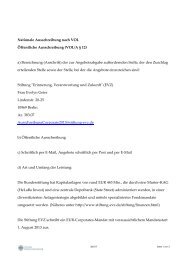chapter 2 - Stiftung "Erinnerung, Verantwortung und Zukunft"
chapter 2 - Stiftung "Erinnerung, Verantwortung und Zukunft"
chapter 2 - Stiftung "Erinnerung, Verantwortung und Zukunft"
You also want an ePaper? Increase the reach of your titles
YUMPU automatically turns print PDFs into web optimized ePapers that Google loves.
Heiner Bielefeldt<br />
An Ongoing Project<br />
Discrimination is still a problem in contemporary Germany – a free and democratic society with a highly<br />
developed legal system and a sophisticated human infrastructure. People from immigrant communities still<br />
experience hurdles in the housing and labor market; even those with equivalent educational attainment have<br />
greater difficulty obtaining an apprenticeship or trainee position compared to young people with more traditionally<br />
“German-so<strong>und</strong>ing” names. Even today, men and women do not receive equal pay for equal work; in<br />
fact, the wage discrepancy is substantial and has remained largely unchanged over the past several decades,<br />
despite numerous corrective policies and measures. Persons with disabilities who wish to marry and establish<br />
families often confront a lack of <strong>und</strong>erstanding and many practical obstacles; this applies in particular<br />
to people with developmental disabilities. Moreover, Germany lags far behind other European nations in the<br />
integration of children with disabilities into regular schools. The educational system also relegates a disproportionate<br />
number of children from immigrant backgro<strong>und</strong>s to schools for children with learning disabilities.<br />
In turn, these children suffer serious and permanent disadvantages through their segregation from the mainstream<br />
at such a young age. Despite some progress, lesbian women and gay men are still stigmatized. Muslims<br />
and other religious minorities often face significant obstacles to participation in established state and<br />
religious structures, such as religious instruction in schools. Furthermore, there has been little systematic<br />
investigation of age discrimination in Germany, and the topic is still largely unknown to the general public.<br />
Even less discussed is the complex issue of discrimination on the basis of genetic features, such the insurance<br />
industry’s discrimination against persons with certain genetic predispositions for disease. This list of<br />
unsolved questions and problems is by no means exhaustive.<br />
For reasons of space, I cannot describe the many different legislative, administrative, social work, and educational<br />
measures needed to enact effective anti-discrimination policies in detail here. Instead, I will close<br />
by indicating an irresolvable tension that all anti-discrimination policies face: the challenge of paying equal<br />
attention to all forms of discrimination, while paying special attention to each.<br />
On the one hand, all forms of discrimination deserve equal attention. Any attempt to establish a hierarchy<br />
of discrimination – for example, by arguing that racial discrimination is more serious than discrimination<br />
against persons with disabilities (or the reverse) – would be contrary to the universalist principle of human<br />
rights. 25 The term “horizontal approach” is now being used to describe the practice of combating all potential<br />
reasons for discrimination <strong>und</strong>er a single anti-discrimination provision. The horizontal approach makes it<br />
possible to address in systematic fashion multiple forms of discrimination, such as the dual discrimination of<br />
women with disabilities or the status of homosexuals from migrant communities.<br />
On the other hand, we must also continue to pay special attention to the unique character of each form of discrimination.<br />
For example, it would be a mistake to conclude that the horizontal approach precludes focused<br />
measures like gender mainstreaming. In order to effectively combat discriminatory practices and structures,<br />
we must thoroughly analyze the social conditions which gave rise to them. This analysis requires that we assess<br />
and <strong>und</strong>erstand each specific form of discrimination. Only a systematic analysis of society allows us to<br />
recognize the wide range of social effects due to gender, for example, or the many obstacles that still prevent<br />
the full accommodation of persons with disabilities of mobility or vision. This specificity will allow us to devise<br />
targeted and precise anti-discrimination polices. The horizontal approach therefore does not imply the<br />
end of gender mainstreaming, disability mainstreaming, or other focused measures in favor of a kaleidoscopic<br />
25 Of course, experiences of discrimination can vary greatly, from a verbal attack to structural discrimination on the housing or employment market to<br />
violence and even genocide.<br />
88<br />
<strong>Stiftung</strong> EVZ<br />
HUMAN RIGHTS AND HISTORY: A CHALLENGE FOR EDUCATION

















